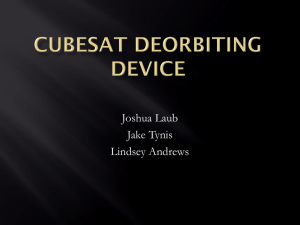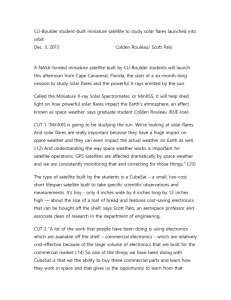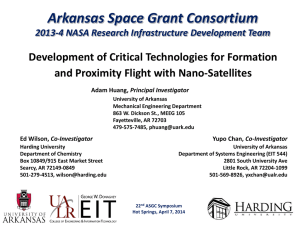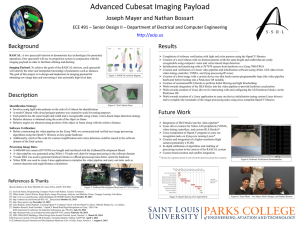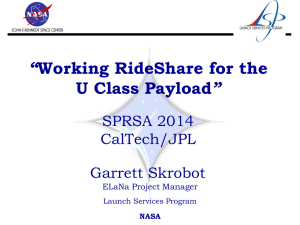UKCF Response 5.2 - UK CubeSat Forum
advertisement
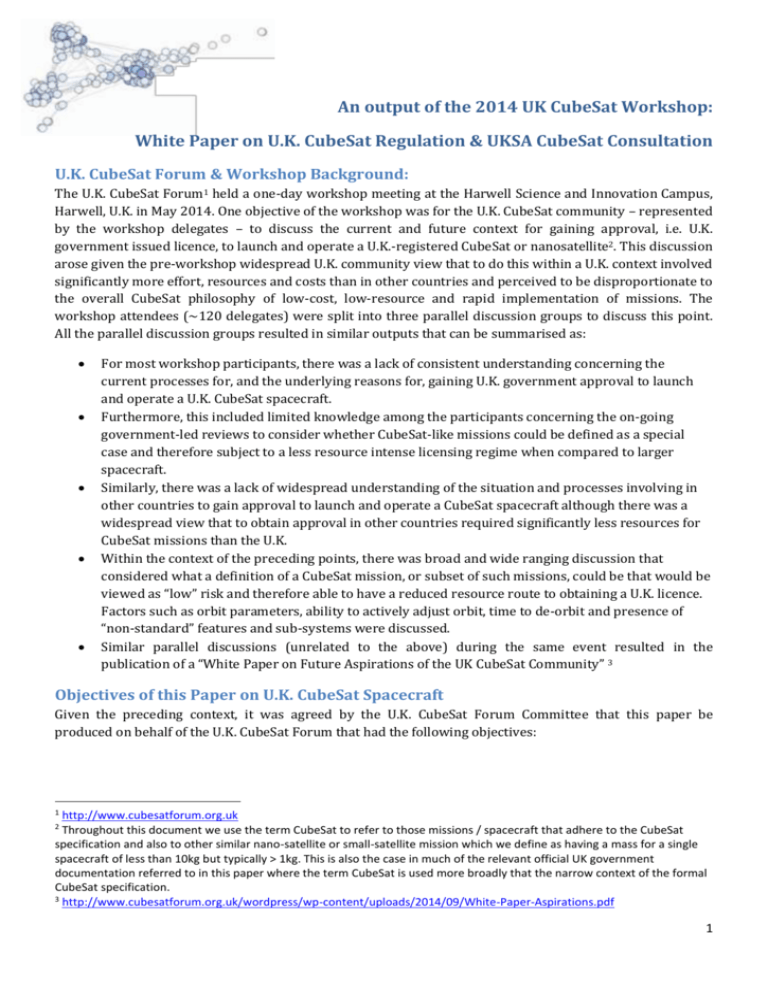
An output of the 2014 UK CubeSat Workshop: White Paper on U.K. CubeSat Regulation & UKSA CubeSat Consultation U.K. CubeSat Forum & Workshop Background: The U.K. CubeSat Forum1 held a one-day workshop meeting at the Harwell Science and Innovation Campus, Harwell, U.K. in May 2014. One objective of the workshop was for the U.K. CubeSat community – represented by the workshop delegates – to discuss the current and future context for gaining approval, i.e. U.K. government issued licence, to launch and operate a U.K.-registered CubeSat or nanosatellite2. This discussion arose given the pre-workshop widespread U.K. community view that to do this within a U.K. context involved significantly more effort, resources and costs than in other countries and perceived to be disproportionate to the overall CubeSat philosophy of low-cost, low-resource and rapid implementation of missions. The workshop attendees (~120 delegates) were split into three parallel discussion groups to discuss this point. All the parallel discussion groups resulted in similar outputs that can be summarised as: For most workshop participants, there was a lack of consistent understanding concerning the current processes for, and the underlying reasons for, gaining U.K. government approval to launch and operate a U.K. CubeSat spacecraft. Furthermore, this included limited knowledge among the participants concerning the on-going government-led reviews to consider whether CubeSat-like missions could be defined as a special case and therefore subject to a less resource intense licensing regime when compared to larger spacecraft. Similarly, there was a lack of widespread understanding of the situation and processes involving in other countries to gain approval to launch and operate a CubeSat spacecraft although there was a widespread view that to obtain approval in other countries required significantly less resources for CubeSat missions than the U.K. Within the context of the preceding points, there was broad and wide ranging discussion that considered what a definition of a CubeSat mission, or subset of such missions, could be that would be viewed as “low” risk and therefore able to have a reduced resource route to obtaining a U.K. licence. Factors such as orbit parameters, ability to actively adjust orbit, time to de-orbit and presence of “non-standard” features and sub-systems were discussed. Similar parallel discussions (unrelated to the above) during the same event resulted in the publication of a “White Paper on Future Aspirations of the UK CubeSat Community” 3 Objectives of this Paper on U.K. CubeSat Spacecraft Given the preceding context, it was agreed by the U.K. CubeSat Forum Committee that this paper be produced on behalf of the U.K. CubeSat Forum that had the following objectives: 1 http://www.cubesatforum.org.uk Throughout this document we use the term CubeSat to refer to those missions / spacecraft that adhere to the CubeSat specification and also to other similar nano-satellite or small-satellite mission which we define as having a mass for a single spacecraft of less than 10kg but typically > 1kg. This is also the case in much of the relevant official UK government documentation referred to in this paper where the term CubeSat is used more broadly that the narrow context of the formal CubeSat specification. 3 http://www.cubesatforum.org.uk/wordpress/wp-content/uploads/2014/09/White-Paper-Aspirations.pdf 2 1 To create a contemporary (2014) summary of the current and known future U.K. context for gaining a U.K. licence to launch and operate a CubeSat as a U.K. registered activity. This would ensure the U.K. CubeSat community are appropriately informed, To offer a U.K. CubeSat community view on how future U.K. licensing could be best revised to allow the full potential of the U.K. CubeSat community to developed, To formally respond to the CubeSat Recommendations from UKSA, and To note that the military use of CubeSats/nano-satellites is outside the scope of this paper. The U.K. context for U.K. CubeSat Licensing The following is a brief summary of the key points that lead to the current context (December 2014) for obtaining a licence to launch and operate any spacecraft, including CubeSats, as an U.K. licensed activity. Historical and current context of the U.K.’s Outer Space Act 1986 The U.K. is a signatory to the UN 1967 Outer Space Treaty4 which provides the basic framework for international space governance and law. Among the principles of the treaty are: o States (not individuals or commercial organisation) shall be responsible for national space activities whether carried out by governmental or non-governmental entities; o States shall be liable for damage caused by their space objects; and o States shall avoid harmful contamination of space and celestial bodies. Furthermore, the UN Convention on International Liability for Damage Caused by Space Objects5 came into force in 1972 which elaborated on Article VII of the UN Outer Space Treaty concerning the international liability responsibilities of space activities … and re-emphasising the roles of states in being responsible for liability. The U.K. Outer Space Act 1986 (OSA)6 was published in July 1986 and came into force on 31st July 19897 as a statutory instrument that addresses the U.K.’s obligations arising from its signing of the UN Outer Space Treaty and the OSA dates from when space activities were seen primarily as a state rather than commercial activity … and therefore decisions were made without the foresight of the emergence of both a major U.K. commercial space sector and CubeSats. The OSA has the purpose to confer licensing and other powers on the U.K. Secretary of State to secure compliance with the international obligations of the U.K. with respect to the launching and operation of space objects and the continuance of other activities in outer space by persons connected with the U.K. The OSA has fifteen sections and of most relevance to the U.K. CubeSat community are the following: o Application of Act Section 1: The Act applies to launching or procuring a launch of a space object, operating a space object and any activity in outer space whether carried out in the U.K. or elsewhere Section 2: The Act applies to U.K. nationals and bodies incorporated under the law of any part of the U.K. o Prohibition of unlicensed activities Section 3: An activity encompassing sections 1 and 2 shall not occur unless under the authority of a licence granted by the U.K. Secretary of State and hence the requirement for such a licence to launch and operate spacecraft including CubeSats o Grant of licence 4 For context see http://www.oosa.unvienna.org/oosa/SpaceLaw/outerspt.html and for the treaty text see http://www.oosa.unvienna.org/pdf/publications/ST_SPACE_061Rev01E.pdf 5 For details see http://www.oosa.unvienna.org/oosa/SpaceLaw/liability.html 6 Outer Space Act 1986 - http://www.legislation.gov.uk/ukpga/1986/38/pdfs/ukpga_19860038_en.pdf 7 The Outer Space Act 1986 (Commencement) Order 1989 - http://www.legislation.gov.uk/uksi/1989/1097/made 2 Section 4: A licence will not be granted unless the activities (a) will not jeopardise public health or the safety of persons or property, (b) will be consistent with the international obligations of the U.K. and (c) will not impair the national security of the U.K. Terms of licence Section 5(f): The licensee is required to insure themselves against liability incurred in respect of damage or loss suffered by third parties, in the U.K. or elsewhere, as a result of the activities authorised by the licence and which meant … … an indemnity from the licensee to the Government against any proven 3rd party costs resulting from the activities - this is an unlimited liability on licensees and … to help manage this indemnity, 3rd party liability insurance (to a minimum of £100 million up to July 2011 and post this date, after intervention by the U.K. government, capped to €60 million) both during the launch and while the satellite is in operation Obligation to indemnify government against claims Section 10: A person to whom the Act applies shall indemnify Her Majesty's government in the U.K. against any claims brought against the government in respect of damage or loss arising out of activities carried on by him/her to which this Act applies – this requires insurance for unlimited liability o o On-going review of U.K. regulatory regime in the context of CubeSat missions In recent years the U.K. space community and government recognised that the U.K. regulatory regime for spacecraft launch and operations resulting from the U.K. OSA was placing an additional burden on U.K. commercial operations compared to commercial operations in other countries with different regulatory regimes. Therefore the U.K. Government Growth Review published in March 2011 included the intention to review the U.K. OSA. The UKSA launched a consultation process in May 2012 to seek views of stakeholders on proposed changes to the OSA to allow U.K.-based space activities to be competitive with other nations. Both a detailed consideration of the context of the U.K. regulatory regime compared to other nations regulatory approaches was presented and suggested changes presented8. This consultation included detailed consideration of CubeSats as a defined class of space activities and proposed a policy option of: o The liability and insurance requirement could be waived for the in-orbit operation of any satellite that meets the criteria of a CubeSat. Assuming the mission could demonstrate scientific or educational merit and that it adhered to the space debris mitigation guidelines which propose a 25 year maximum orbital lifetime after the end of the mission.9 The liability and insurance requirement would remain for the launch of the mission. The liability could be accepted by the U.K. Government as the risks arising from the operational phase of a CubeSat or similar mission are proposed to be significantly reduced compared to a standard satellite (see 8). In July 2012 and with immediate effect, the U.K. Science Minister David Willetts announced that the insurance requirement as part of licensing would be reduced to €60 million – from £100 million – with immediate effect. Results of the consultation were published in late 201310. This resulted in two key outcomes: o The responses led the Government to decide to set in motion the process required to cap the current unlimited liability to €60 million, for the majority of envisaged missions. The favoured route to achieve this was via a Legislative Reform Order which would give the Secretary of State the power to set / vary this liability limit as required 8 https://www.gov.uk/government/uploads/system/uploads/attachment_data/file/298017/impact-assessment-reform-ofthe-outer-space-act.pdf 9 If the spacecraft’s mission is expected to last for 5 years, as may be the case with CubeSat/nano-class satellites, then the proposed orbital lifetime of that satellite might be 30 years. 10 https://www.gov.uk/government/uploads/system/uploads/attachment_data/file/295769/gov-response-osaconsultation.pdf 3 As a result of respondent’s comments it was decided that more consideration should be given before waiving the liability and insurance requirement for the in-orbit operation of CubeSat. Thus the Government continues to consider its policy regarding the treatment of CubeSats. o The primary comments that lead the Government to consider further the CubeSat context appears to be the risks and therefore liabilities associated with collisions of CubeSats with other space objects The UKSA is continuing to review the U.K. regulatory regime for CubeSats and with guidance to be published on UKSA website by Q4 FY201411. o Since this time, further consultation is requested by the UKCF and the UKSA on CubeSats12. This is addressed at the end of this document. o Summary of current requirements to obtain a U.K. licence to launch and operate a CubeSat At present (December 2014) CubeSat missions are treated to the same licensing requirements as all other space activities – such a large commercial satellites. The current approach to obtain a U.K. licence to launch or operate a spacecraft, satellite or manage other activities in outer space, under the U.K. Outer Space Act 1986 is briefly summarised in the following text. This information is summarised from the information present on the relevant pages of the United Kingdom public sector information website (GOV.UK)13. A licence application form14, further guidance for applicants including stating the fee for application of £6,500 15 and an example of a licence document16 are publically available. Application for a licence should be submitted at least six months in advance of any plans for launch or operation It is stated that “There is flexibility in the U.K. approach to licensing and the U.K. Space Agency encourages potential applicants to contact them as early as possible to discuss the best way forward and solution for their mission”17. Substantive requirements for the application comprise of: o the nature of the space activity the applicant is proposing to carry out; o applicant’s legal status; o the applicant’s financial standing to ensure appropriate financial health; o mission costs; o insurance arrangements for launch (if applicable) and in-orbit phase of the mission (including copies of all certificates and policies); o technical details of the mission which should cover the design and construction of the satellite, the launch arrangements, telemetry, tracking, and command facilities, operation, and in-orbit functioning (including copies of the launch services contract, satellite supply contract and technical specifications and ground station specification); o plans for the disposal of the space object at end of life; o emergency procedures; o radio frequencies and powers used during the mission; 11 UK Space Agency Corporate Plan 2014-15 pg 14 https://www.gov.uk/government/uploads/system/uploads/attachment_data/file/307613/Corporate_Plan_2014-15.pdf 12 https://www.gov.uk/apply-for-a-license-under-the-outer-space-act-1986#cubesat-regulation 13 https://www.gov.uk/apply-for-a-license-under-the-outer-space-act-1986#background-to-the-legislation 14 https://www.gov.uk/government/uploads/system/uploads/attachment_data/file/320160/OSA_Application_Form__June_2014_-_word_version.pdf 15 https://www.gov.uk/government/uploads/system/uploads/attachment_data/file/320158/Guidance_for_applicants__June_2014.pdf 16 https://www.gov.uk/government/uploads/system/uploads/attachment_data/file/295767/example-of-an-osalicense2008.pdf 17 https://www.gov.uk/apply-for-a-license-under-the-outer-space-act-1986#applying-for-a-licence 4 o orbital location information The licensing system includes a technical review of the launch and operation of a spacecraft. This is aimed at informing the Government of any undue risks concerned with the mission. This information is used to facilitate the decision on whether or not to grant a licence or whether it should be granted subject to certain conditions. OFCOM are required to undertake the ITU procedures of notification and registration on behalf of the applicant. This registration is required to ensure that the proposed frequencies, the proposed ITU service and coverage are compatible with other existing users. Generally ITU have a cost recovery scheme for making charges back through the national administration and it may be expected that OFCOM would pass these on to the applicant. This charge is not levied for spacecraft operating in the Amateur Satellite Service. Spacecraft operating in the Amateur Satellite Service usually undertake precise frequency coordination with the International Amateur Radio Union (IARU) in parallel with the initial Advance Publication Information (API) procedures of the ITU18. Responses to Recommendations: This section details the UKCF’s responses to the UKSA’s consultation document on CubeSat regulation. The consultation document details the UKSA’s proposed approach to CubeSat regulation within the context of the U.K. OSA and outlines a number of recommendations for consideration by the U.K. space community. RECOMMENDATION 1: United Kingdom Space Agency conduct an assessment of CubeSat launch systems/scenarios and identify on its website those launchers/situations which would attract a GREEN rating (acceptable for OSA licence issue) under particular conditions. RECOMMENDATION 2: U.K. Space Agency technical assessors exploit/re-use launch vehicle specific data provided as part of previous CubeSat licence applications and associated assessments where appropriate to provide potential savings to both licence applicant and regulatory authority. Recommendations 1 and 2 are supported within the UKCF as there may be a route to speeding up and reducing paperwork/processes to obtain a space or export license. The questions, risks and issues raised within the forum are summarised below: Costs may be increased by launch providers if further demand is placed on “U.K.” CubeSats. Guidance is needed on how new current and future CubeSat-dedicated, new small rockets and future launch systems be added to the assessment. E.g. Green only with heritage? Level of testing required for assessment? Any non-green (or non-rated) rated launcher, may make the process slower. Further context on the current process and how this will speed up in the new approach would help to show to potential developers the benefits of UKSA technical assessments on launch. RECOMMENDATION 3: 18 http://www.iaru.org/uploads/1/3/0/7/13073366/ars-tutorial.pdf 5 Applicable international standards should be employed to specify those standard aspects of CubeSats platforms which can provide safety assurances about the intrinsic hazards presented by the CubeSat satellite and its subsystems to other space systems. Recommendation 3 is supported within the UKCF as there are existing documents available; most notably the CubeSat Design Specifications19 which are extensively used at NASA. Further comments: This recommendation is assumed to apply to both pre-launch, launch, and post deployment on the launcher and needs clearer guidance on how waivers can be fully utilised with respect to CubeSat platform risks (not the launcher or deployer). o The forum discussed how the existing waiver process could become common place to show regulators home and abroad how risk is understood and managed. The UKSA should consider it’s appetite for following the waiver process. A prescriptive or required ISO Standard would not be seen as helpful as it may limit what is possible with a CubeSat. This is also true of ECSS and CCSDS standards. o U.K. developers should be free to build the CubeSat in any way possible so long as it can be reliably and safely ejected from a POD deployer. o Reference to standards or guidelines applied in full or part during a CubeSat development can help provide extra assurance that processes undertaken by a developer are robust, and may help UKSA understanding of commonly used standards or guidelines and in assessing their worth. Propulsion needs specifically addressing as it will become common place in the future. RECOMMENDATION 4: In the case of distributed CubeSat systems, due consideration should be given by the U.K. Space Agency in the OSA technical assessment to the quantity of CubeSats to be licenced, both in terms of the number on a particular launch, and the overall constellation involved, in terms of the collision risks posed to other orbital systems both during and after the operational phase of the mission, and the potential impact on long term sustainability of the orbital environment. Recommendation 4 is supported but need further clarification: 19 The perceived collision risk is a large source of contention within the CubeSat community, and some give and take is needed as a whole. o The forum fully supports the understanding that U.K. CubeSat developers: Must not willingly contribute to further debris creation, Agree that appropriate regulation must protect the space environment we all use, and That all liabilities are covered. o The forum wishes to express the real financial and scientific risk to U.K. business and academia that if cost, risk, and innovation are not carefully balanced in regulation that U.K. CubeSat developers will be disadvantaged to international CubeSat developers. o The U.K. CubeSat community wishes to be ambassadors via the UKCF in safe and accessible space practice for the world to follow. An internationally agreed, open-source and standardised method should be made available to U.K. developers to better understand their perceived orbital and operational risk. CalPoly, Useful CubeSat Documents www.cubesat.org/index.php/documents/developers 6 There must be clear descriptions on when a “CubeSat is not a CubeSat” and how future regulations will be applied. The forum wishes that these CubeSat specific regulations may form further recommendations across all satellite masses/volumes/applications; “A space object is a space object”20. RECOMMENDATION 5: Given the commonality of both the CubeSat platform and launch delivery systems for constellations of CubeSats, U.K. Space Agency should explore how sets of satellites and/or launches could be collectively authorised under a single licence fee, offering significant savings to both OSA licence applicants and the regulatory authority. Recommendation 5 is supported but need further clarification: For constellations or distributed satellite missions, it is well supported that a streamlined paperwork scheme is needed so that similar satellites (with negligible differences) and orbits can be formed under one fee for space and export licenses. o There is a need for this to apply to multiple launch/orbit scenarios as launch manifests and developments change. There needs to be further guidance from the UKSA on the difference between 100 CubeSats from one entity and one CubeSat from 100 entities. RECOMMENDATION 6: In its OSA licence assessment, the U.K. Space Agency should recognise that: CubeSats without propulsive capability should not be injected into orbits with a natural decay lifetime greater than 25 years. CubeSats can be injected into orbits with natural decay lifetimes greater than 25 years if they carry on-board propulsive capability and sufficient reliability and fuel margin to effect a de-orbit at end of life to a lower disposal altitude which does comply with the 25 year rule. CubeSats can be injected into orbits with natural decay lifetimes greater than 25 years if they carry on-board a disposal system to enhance the drag on the platform and thereby effect a de-orbit over time to lower altitudes such that the CubeSat platform can comply with the 25 year rule and it can be shown that this reduces the aggregated collision risk over the period in orbit. Recommendation 6 is supported by the UKCF as responsible space use is a priority for all satellite developers. 20 The UKCF believe there may be issue in applying a ‘green’ rating to a U.K. CubeSat if newly developed (i.e. non-space qualified) sail, inflatables, or propulsion systems are used. o The forum discussed how CubeSat Design Specification waivers can be fully utilised, and demonstrated risk mitigation actions taken to allow ‘green’ ratings. As deorbit systems are not well developed in the U.K., further funding by U.K. stakeholders is needed to drive the technology readiness level in this area. Sails and inflatables overall reduce the collision risk by reviewing the integrated area to time product (ATP) which should be taken as a baseline forward in modelling. J. Wheeler, Partner, Bird & Bird, U.K. Space Conference: http://www.ukspace2015.co.uk/presentations/99 7 Again, a suitable orbit and deorbiting model framework is to be agreed and baselined for all U.K. CubeSat missions. Referencing the IADC, the recommendation wording needs careful consideration to allow U.K. CubeSat missions to target exotic, MEO, and interplanetary orbit scenarios to compete with international aspirations and missions. There is an observation that launch providers may increase costs to meet U.K. deorbit regulations – potentially leaving U.K. CubeSat missions at a disadvantage. This may be financially offset however through a ‘green’ rating and subsequent waiving TPL. RECOMMENDATION 7: A set of criteria corresponding to GREEN evaluation should be developed for the each of the launcher, platform design/operation and orbital aspects of the mission. These criteria should reflect both the potential risk posed to the system by the background environment and the possible risks posed by the system to other missions. In establishing these criteria, due consideration should be given to recognising best practice measures (both in terms of design and operation), and reflected accordingly (e.g. exploiting community/international standards such as ISO where they exist) in any analysis. Recommendation 7 is supported: Existing criteria is already in use by large space institutions and described in the CubeSat Specification Documents where the waiver process could be followed to understand and mitigate risks. There is very real concern on where the green, orange, and red boundaries will be and that members of the CubeSat community are used in evaluations rather than existing satellite industry experts. Again, the forum believes is not helpful to prescribe ESA, ECSS, CCSDS, and ISO standards given the flexible nature of the CubeSat standard, but may recognise their application. RECOMMENDATION 8: A financial impact assessment should be conducted by U.K. Space Agency to consider the benefit to the CubeSat industry of waiving the third party insurance cover currently required under the Outer Space Act for CubeSat missions judged not to expose the U.K. to potential in-orbit liability claims. This recommendation is unanimously supported: Many CubeSat groups are financially constrained to small project budgets and as such TPL makes the U.K. unattractive to U.K. CubeSat developers. This can be evidenced by the FUNcube-1 ‘sell-off’, Spire build work at Clyde Space 21, and the lack of U.K. CubeSat missions compared to other nations. It is proposed that a green rated CubeSat could be automatically waived of TPL. For amber or red rated CubeSats, an assessment should take place that balances financial, risk, innovation, and opportunity – not only financial risks. Summary: The U.K. CubeSat Forum appreciates and supports the work the U.K. Government, through the U.K. Space Agency, is performing to ensure wherever possible that the U.K. CubeSat community is able to operate competitively with organisations operating in other nations. 21 P. Platzer, Spire, U.K. Space Conference Presentation, http://www.ukspace2015.co.uk/presentations/100 8 The published recommendations from the UKSA are very welcome by the UKCF members and the community as a whole. Key areas that overall need to be planned are 1) how the community can help in defining useful and accessible processes and rating systems and 2) what timeline these recommendations are to be held to. Some members of the UKCF wish to express how actions are “this year, and not the next” – and the UKCF is willing to be constructive and helpful to the UKSA where possible. For future green rated systems to be developed, there must be a clear route to orbit in the U.K. by U.K. stakeholders for in-orbit-demonstration, seed funding for both scientific and engineering problems, and in operations costs. If coupled with a U.K. launcher, this would make the U.K. very attractive to new investments and research programmes for safe, reliable and sustainable growth within the space market. Authors: Chris Bridges, Surrey Space Centre (Chair) David Cullen, Cranfield University Ross Burgon, Open University Corentin Guillo, Satellite Applications Catapult Graham Shirville, AMSAT-UK Steve Greenland, Clyde Space Matthew Waldram, PlanetLabs Bob Dalgleish, Roke Manor 9

